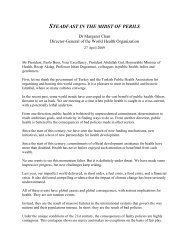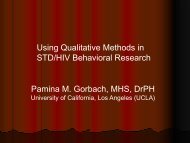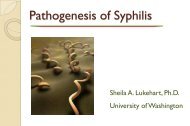The Evolution of HTA in Emerging Markets Health-Care ... - TREE
The Evolution of HTA in Emerging Markets Health-Care ... - TREE
The Evolution of HTA in Emerging Markets Health-Care ... - TREE
You also want an ePaper? Increase the reach of your titles
YUMPU automatically turns print PDFs into web optimized ePapers that Google loves.
OHE Consult<strong>in</strong>g Report for PhRMA<br />
5 January 2011<br />
A.2.3 <strong>The</strong> <strong>in</strong>itiation <strong>of</strong> health coverage reform <strong>in</strong> 2003<br />
Major health care reform began <strong>in</strong> 2003 to rebuild the fail<strong>in</strong>g CMS and LIS schemes. Ch<strong>in</strong>a now has<br />
three major healthcare <strong>in</strong>surance schemes (Liu et al., 2009):<br />
<br />
<br />
<br />
<br />
<strong>The</strong> New Rural Cooperative Medical Scheme (NRCMS, also known as the NCMS). NRCMS is a<br />
subsidized health <strong>in</strong>surance scheme for rural populations (<strong>of</strong>fer<strong>in</strong>g benefits cover<strong>in</strong>g<br />
primarily <strong>in</strong>patient care and major outpatient expenses) with voluntary enrolment on a<br />
family basis. <strong>The</strong> <strong>in</strong>tention is to move the benefit package away from <strong>in</strong>surance for<br />
expensive hospital care to one risk pool for <strong>in</strong>patient and outpatient services; encourag<strong>in</strong>g<br />
coverage for treatments for chronic conditions. <strong>The</strong> scheme <strong>in</strong>volves a subsidy <strong>of</strong> RMB 80<br />
($11.40) (made up <strong>of</strong> 50% each com<strong>in</strong>g from central and local governments) towards an<br />
annual premium <strong>of</strong> RMB 100 ($14.30) with <strong>in</strong>dividuals’ contribution set at RMB20 ($2.90).<br />
Patient co-‐payment is <strong>in</strong> the region <strong>of</strong> 50-‐60%. <strong>The</strong>re is however a separate Medical<br />
Assistance Safety Net, which helps the poor pay their NRCMS premiums and reduces their<br />
co-‐payment rates.<br />
<strong>The</strong> Urban Employment Basic Medical Insurance (UEBMI) is a mandatory <strong>in</strong>surance scheme<br />
for formal sector workers <strong>in</strong> urban areas cover<strong>in</strong>g 200 million urban employed people. <strong>The</strong><br />
UEBMI is, <strong>in</strong> Chen, Banta and Tang (2009), referred to as National Urban Social Medical<br />
Insurance Scheme for Employees and Retirees (USMISER). F<strong>in</strong>anc<strong>in</strong>g <strong>of</strong> the UEBMI comes<br />
from 8% payroll tax, 6% from employers and 2% from employees for coverage for essential<br />
healthcare.<br />
<strong>The</strong> Urban Resident Basic Medical Insurance (URBMI). <strong>The</strong> URBMI is a voluntary subsidized<br />
<strong>in</strong>surance scheme for urban residents not <strong>in</strong> formal employment <strong>in</strong>clud<strong>in</strong>g children and<br />
students. In Chen, Banta and Tang (2009), this is referred to as the national Urban Resident<br />
Medical Insurance Scheme (URMIS).<br />
<strong>The</strong> role <strong>of</strong> private <strong>in</strong>surance is small and restricted to <strong>of</strong>fer<strong>in</strong>g complementary or<br />
supplementary health <strong>in</strong>surance benefits (to that <strong>of</strong>fered by the three other schemes) (Liu et<br />
al, 2009).<br />
In addition there is a Government Insurance System for government employees, but there is an<br />
expectation that it will be <strong>in</strong>tegrated with the UEBMI.<br />
A2.4 Rema<strong>in</strong><strong>in</strong>g Challenges and Other aspects <strong>of</strong> reform<br />
<strong>The</strong> extent <strong>of</strong> <strong>in</strong>tegration <strong>of</strong> the health <strong>in</strong>surance schemes<br />
<strong>The</strong> current <strong>in</strong>surance platforms aim to cover different people at different locations, which currently<br />
still leaves a large number <strong>of</strong> people out <strong>of</strong> the <strong>in</strong>surance pool. <strong>The</strong> M<strong>in</strong>istry <strong>of</strong> Human Resources<br />
and Social Security (MoHRSS) is responsible for the UEBMI and the URBMI. <strong>The</strong> M<strong>in</strong>istry <strong>of</strong> <strong>Health</strong><br />
(MoH) is responsible for the NRCMS. <strong>The</strong> Prov<strong>in</strong>ces also play an important role <strong>in</strong> the adm<strong>in</strong>istration<br />
86








